|
80x5 -
240x3 -
240x4 -
320x1 -
320x2 -
320x3 -
640x1 -
640x2
Set display option above.
Click on
images to enlarge. |
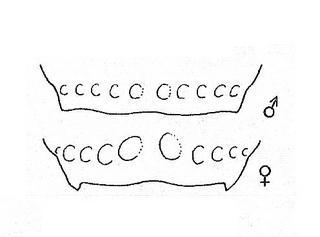
R. M. Bohart L. S. Kimsey, 1982 · 1
Chrysura cobaltina, tail |
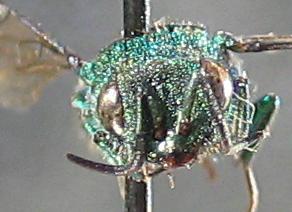
Native Bee Inventory and Monitoring Lab; Photographer: Erika Tucker · 1
Chrysura cobaltina, face |
|
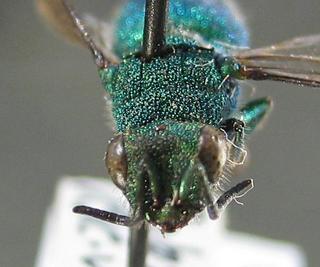
Native Bee Inventory and Monitoring Lab; Photographer: Erika Tucker · 1
Chrysura cobaltina, head |
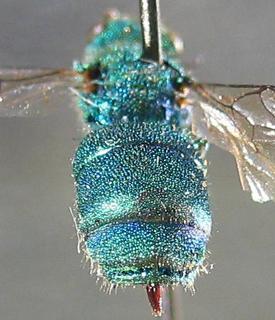
Native Bee Inventory and Monitoring Lab; Photographer: Erika Tucker · 1
Chrysura cobaltina, tail |
|
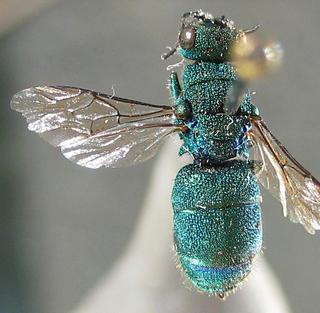
Native Bee Inventory and Monitoring Lab; Photographer: Erika Tucker · 1
Chrysura cobaltina, top |
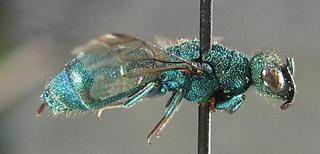
Native Bee Inventory and Monitoring Lab; Photographer: Erika Tucker · 1
Chrysura cobaltina |
|
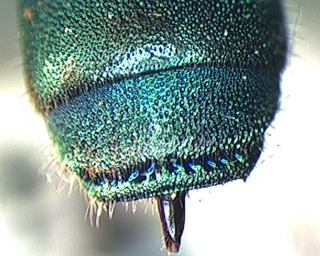
Native Bee Inventory and Monitoring Lab; Photographer: Erika Tucker · 1
Chrysura cobaltina, female, tail |
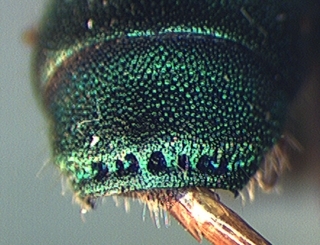
Native Bee Inventory and Monitoring Lab; Photographer: Erika Tucker · 1
Chrysura cobaltina, female, tail |
|
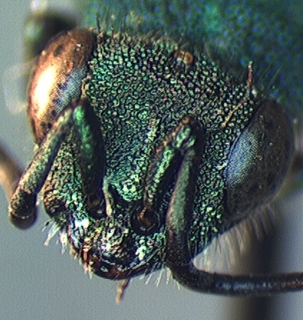
Native Bee Inventory and Monitoring Lab; Photographer: Erika Tucker · 1
Chrysura cobaltina, face |
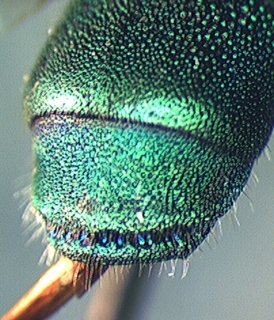
Native Bee Inventory and Monitoring Lab; Photographer: Erika Tucker · 1
Chrysura cobaltina, male, tail |
|
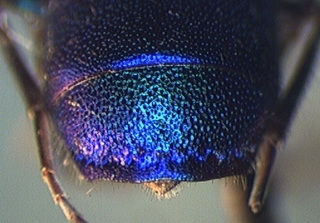
Native Bee Inventory and Monitoring Lab; Photographer: Erika Tucker · 1
Chrysura cobaltina, male, tail |
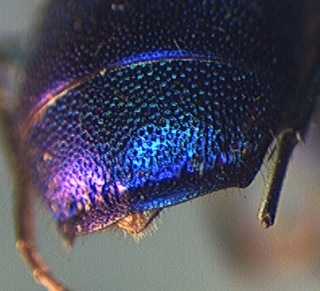
Native Bee Inventory and Monitoring Lab; Photographer: Erika Tucker · 1
Chrysura cobaltina, male, tail |
|
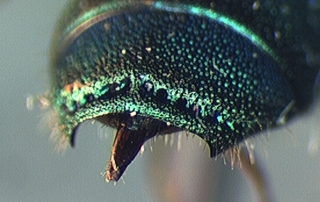
Native Bee Inventory and Monitoring Lab; Photographer: Erika Tucker · 1
Chrysura cobaltina, tail |
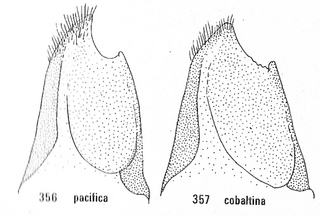
R. M. Bohart and L. S. Kimsey, 1982 · 1
Chrysura cobaltina, male paramere |
|
Overview |
Taken from:
R. M. Bohart and L. S. Kimsey. 1982. A Synopsis of the Chrysididae in America North of Mexico.
Chrysura cobaltina (Aaron)
(Figs. 322, 357)
Chrysis cobaltina Aaron 1885:228. Holotype male (not female), Mass. (ANSP).
Chrysis lateri-dentata Aaron 1885:228. Lectotype female, Montana (ANSP).
Discussion: agreeing with the characters given for pacifica except as follows:
14. T-III apical margin somewhat wavy and medially indented, rather sharply cornered in semilateral view in male, angled backward toothlike in female (fig. 322).
16. Modal body length 7.5 mm in both sexes.
The shape of T-III is diagnostic (fig. 322). The prominent lateral corners are best seen in semilateral view. Punctation of T-II is fairly uniform but somewhat more coarse than in pacifica. Integument color varies from green to blue green but in our material never reaches the intense dark blue seen in some tota. The paramere of the male genitalia is similar to that of pacifica (compare figs. 356, 357).
Material examined: 35 males. 44 females including types of cobaltina and lateridentata.
Distribution: transcontinental between 37° and 48° latitude except for some records in the mountains of southern California and Baja California. Most specimens have been collected in Upper Sonoran to Canadian Life Zones in the west and Upper Austral and Canadian in the east.
Subgenus Olochrysis Lichtenstein
Olochrysis Lichtenstein 1876:27. Generotype: Chrysis aerata Dahlbom 1854 (Chrysis rimaculata Fφrster 1853), designated by Ashmead 1902.
Holochrysis Rye 1878:134. Emendation of Olochrysis.
Conochrysis Haupt 1956:37. Generotype: Chrysis refulgens Spinola 1806, original designation.
Taeniochrysis Haupt 1956:72. Generotype: Chrysis dichroa Dahlbom 1854, original designation.
Species of Olochrysis have male F-II-IV swollen beneath and the metanotum slightly to strongly conical.
Palearctic Olochrysis we have studied are cuprea (Rossi), dichroa (Dahlbom), filiformis (Mocsary), hirsuta (Gerstaeker), loevigata (Abeille), lydiae Mocsary, purpureifrons (Abeille), pustulosa (Abeille), refulgens (Spinola), rufiventris (Dahlbom), sulcata (Dahlbom), trimaculata (Forster), and varicornis (Spinola). Several of these, but particularly refulgens, have the metanotum more produced than in nearctic forms. A few species, such as rufiventris, sulcata and varicornis have the apical margin of T-III deflected much as in Ceratochrysis kansenis. Of the European species the one most similar to those of the New World may be hirsuta. Except for the bright coppery abdomen common to most palearctic species, hirsuta resembles pacifica and smaragdicolor in many respects.
In the nearctic fauna we recognize nine species. This compares with 46 Olochrysis recorded by Linsenmaier (1959) for the palearctic fauna. Five of our species are relatively homogeneous from a structural standpoint. The other four, crescentis, inusitata, sonorensis and sagmatis are less so. The hosts of sagmatis in twig nests are primarily megachilid genera other than Osmia. Hosts of the other three species, when known, may help explain their differences.
Characters of special importance in separation of Chrysura are punctation, pubescence, ocellar placement in relation to each other and to the compound eyes, shape of P-HI, and form of the male paramere. The dark spots of S-II are often ephemeral and contrary to the situation in Trichrysis, Neochrysis and many Chrysis, are of limited diagnostic value.
The following key will separate the nearctic species without special difficulties except in the problem of pacifica versus kyrae. Here the most critical character lies in the male genitalia.
Key to Chrysura
1. Malar space less than 2 MOD, propodeal angles not strongly projecting (fig. 316)
inusitata (Aaron)
Malar space more than 2 MOD (fig. 316), propodeal angles projecting (fig. 321)
2
2. Interocellar distance equal to or very slightly less than ocellocular distance
.3
Interocellar distance plainly less than ocellocular distance
5
3. T-III broadly and distinctly concave posteriorly (fig. 325), pit row in both sexes preceded by a strong transverse swelling and a distinct saddle
.sonorensis (Cameron)
T-III posterior margin slightly concave, straight or convex (figs. 322, 323, 324) with or without a slight to moderate swelling and saddle preceding pit row
.4
4. T-II medially about 2.5 times as long as F-I and about three fifths as long as broad; female F-III apical margin straight or a little concave (fig. 324)
sagmatis Bohart
T-II about 3.0 times as long as F-I and about two thirds or more as long as broad; female F-III apical margin evenly rounded out; unusually small species, about 3.5 mm long
.crescentis Horning
5. Pubescence of hindcoxa and midtibia black; a relatively large species, often 10 mm long
..tota Aaron
Pubescence of hindcoxa and midtibia pale
6
6. Apical margin of T-III in semilateral view rather sharply cornered in male, angled toothlike in female, margin apicomedially indented slightly in both sexes (fig. 322)
...cobaltina (Aaron)
Apical margin of T-Ill not sharply cornered, sometimes broadly obtuse, or evenly rounded, margin posteriorly variable
.7
7. T-III apical margin strongly convex, pit row unusually weak (fig. 323)
.boharti Horning
T-III apical margin straight or only slightly convex, pit row usually distinct
8
8. Pronotum with coarse and contiguous punctures, many of which are nearly as large as a lateral ocellus; a rather large species, male often 8 mm long and females 10 mm
.smaragdicolor (Walker)
Pronotum with moderate punctation, often somewhat separated, individual punctures considerably smaller than a lateral ocellus; most males less than 8 mm long and most females less than 10 mm
.9
9. Subantennal distance with blue or green area more than 1.5 times as long as interantennal distance, often nearly twice as long (fig. 317)
..pacifica (Say)
Subantennal distance with blue or green area less than 1.5 times as long as interantennal distance, often about equal (fig. 318)
.kyrae Krombein
Chrysura Dahlbom
Donald S. Horning, Jr. and P. M. Bohart
The genus Chrysura, as we define it, has the following characteristics: Scapal basin relatively flat to gently concave, without a definite central zone of cross ridging, not bounded above by a cross carina (fig. 316); malar space nearly always elongate, (2.5 MOD or more) and usually longer than subantennal distance; F-I more than twice as long as broad in both sexes, F-I plus pedicel as long as or longer than scape; pleuron relatively simple, not dentate; marginal cell narrowed and narrowly closed at apex by extension of RS; T-III without definite teeth and usually without a definite apicomedian notch, apicolateral angles sometimes prominent; male paramere stout, without a discrete telomere.
Chrysura is a holarctic genus and the palearctic species have been treated by Linsenmaier (1959). In this valuable contribution he emphasized the importance of the ventral swellings beneath F-II-IV in the male. This put the austriaca group (Chrysura s.s.), which lacks the swellings, into subgenus Chrysura s.s. and the remaining groups (Linsenmaiers Abteilung A) into subgenus Chrysogona Forster. In our opinion Chrysogona, based on its generotype Chrysis gracillima Fφrster, is relatively unrelated. The structure of the face is different and several of the species have a definitive cross carina on the frons. Our concept of Chrysura includes two subgenera: Chrysura s.s. (or the austriaca group) and Olochrysis (or the trimaculata group (pustulosa, cuprea and dichroa groups of Linsenmaier). American species all belong to Olochrysis.
Hosts for both subgenera are Megachilidae and predominantly Osmia. In contrast, the host of Chrysogona gracillima is a eumenid, Odynerus, another reason for excluding it.
|
|
| Supported by | |
Updated: 2024-04-28 09:10:11 gmt
|